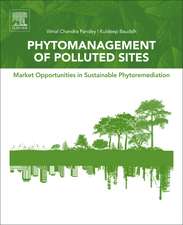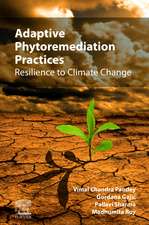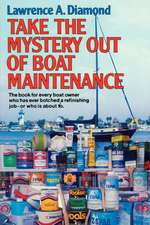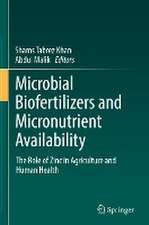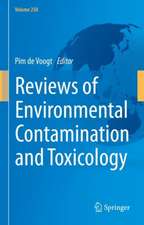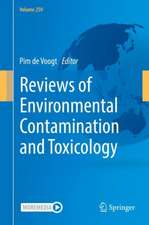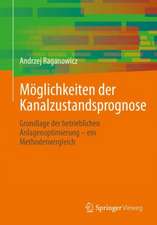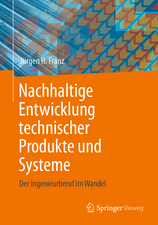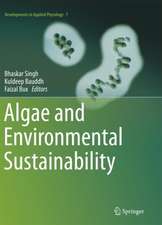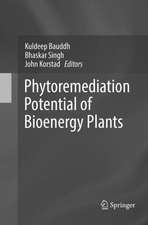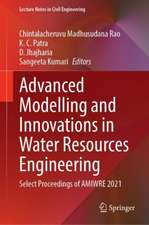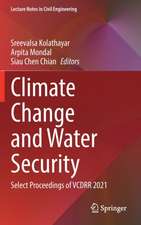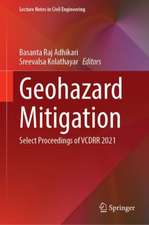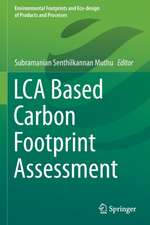Phytorestoration of Abandoned Mining and Oil Drilling Sites
Editat de Kuldeep Bauddh, John Korstad, Pallavi Sharmaen Limba Engleză Paperback – 19 noi 2020
Utilizing worldwide examples, this book discusses the potential of phytoremediation as an ideal solution for sites contaminated by mining and oil drilling sites.
- Includes exploration of efficient plants for restoring contaminated former mining and oil drilling sites
- Addresses adverse impacts of toxicants released from mining activities on living organisms, including human health
- Presents characteristics of contaminated former mining and oil drilling sites
Preț: 918.50 lei
Preț vechi: 1222.05 lei
-25% Nou
Puncte Express: 1378
Preț estimativ în valută:
175.78€ • 190.87$ • 147.65£
175.78€ • 190.87$ • 147.65£
Carte tipărită la comandă
Livrare economică 16-30 aprilie
Preluare comenzi: 021 569.72.76
Specificații
ISBN-13: 9780128212004
ISBN-10: 0128212004
Pagini: 538
Dimensiuni: 191 x 235 x 31 mm
Greutate: 0.91 kg
Editura: ELSEVIER SCIENCE
ISBN-10: 0128212004
Pagini: 538
Dimensiuni: 191 x 235 x 31 mm
Greutate: 0.91 kg
Editura: ELSEVIER SCIENCE
Public țintă
Students, Academics, Environmentalists, Ecologists, Geologists, Industrialists, and Soil ScientistsCuprins
1. Characteristics of Former Mining and Oil Drilling Sites and Adverse Impacts of These Activities on the Environment and Human Health
2. An Overview of Phytorestoration of Former Mining and Oil Drilling Sites
3. Contamination of the Stream Water and Sediments with Uranium Mine and Their Possible Phytoremediation
4. Influence of Open Cast Mining on the Soil Properties of Ledo Colliery of Tinsukia District of Assam, India
5. Potential of Purun tikus to Restore the Iron (Fe) Contaminated Acid Mine Drainage by Using Constructed Wetland
6. Phytoreclamation of Abandoned Acid Mine Drainage Site after Treatment with Fly Ash
7. Role of Fungi in Restoration of Mine Dump Soil Contaminated with Petroleum Hydrocarbons
8. Assessment of Native Plant Species Growing in Mining-Spoiled Soils for Phytorestoration of Heavy Metals
9. Assessment of Phytoremediation Potential of Plant Species in Copper Mine Tailings
10. Phytostabilization of Metalliferous Mine Waste
11. Restoration of Coal Mine Waste Sites by Using Plant Species
12. Phytoaccumulation of Trace Elements by Grevillea pteridifolia Knight Grown on Iron Ore Tailings
13. Evaluation of Natural Phytoremediation Processes Occurring at Ex-Tin Mining Catchment
14. Uranium Mine Tailing Remediation by Amending Land Soil and Invading Native Plant Species
15. Physiological and Antioxidant Responses in Plants Exposed to Heavy Metals During Cultivation in Mining Dump Sites
16. Potential of Ricinus communis for the Removal of Toxic Metals from Mining Dumping Sites
17. Phytorestoration Potential of Invasive Plant Species during Cultivation in Mining Dump Sites
18. Phytoextraction of Heavy Metals by Tree Species Growing on Hazardous Mining Sludge
19. Selection of Plant Species for Phytoremediation of Oil Drilling Sites: An Overview
20. Phytoremediation Study of Oil Spill Site Using Common Nigerian Vegetables
21. Case Studies of Phytorestoration of Abandoned Oil Drilling Sites
22. Phytoremediation of Oil Contaminated Aquatic Sites using Aquatic Macrophytes
23. Phytomining: A Sustainable Approach for Recovery and Extraction of Valuable Metals
24. Phytomining Potential of Albizia julibrissin Plant
25. Restoring Indigenous Knowledge for Mining Dump Sites: A Study at Iron Mining Areas in Jharkhand
2. An Overview of Phytorestoration of Former Mining and Oil Drilling Sites
3. Contamination of the Stream Water and Sediments with Uranium Mine and Their Possible Phytoremediation
4. Influence of Open Cast Mining on the Soil Properties of Ledo Colliery of Tinsukia District of Assam, India
5. Potential of Purun tikus to Restore the Iron (Fe) Contaminated Acid Mine Drainage by Using Constructed Wetland
6. Phytoreclamation of Abandoned Acid Mine Drainage Site after Treatment with Fly Ash
7. Role of Fungi in Restoration of Mine Dump Soil Contaminated with Petroleum Hydrocarbons
8. Assessment of Native Plant Species Growing in Mining-Spoiled Soils for Phytorestoration of Heavy Metals
9. Assessment of Phytoremediation Potential of Plant Species in Copper Mine Tailings
10. Phytostabilization of Metalliferous Mine Waste
11. Restoration of Coal Mine Waste Sites by Using Plant Species
12. Phytoaccumulation of Trace Elements by Grevillea pteridifolia Knight Grown on Iron Ore Tailings
13. Evaluation of Natural Phytoremediation Processes Occurring at Ex-Tin Mining Catchment
14. Uranium Mine Tailing Remediation by Amending Land Soil and Invading Native Plant Species
15. Physiological and Antioxidant Responses in Plants Exposed to Heavy Metals During Cultivation in Mining Dump Sites
16. Potential of Ricinus communis for the Removal of Toxic Metals from Mining Dumping Sites
17. Phytorestoration Potential of Invasive Plant Species during Cultivation in Mining Dump Sites
18. Phytoextraction of Heavy Metals by Tree Species Growing on Hazardous Mining Sludge
19. Selection of Plant Species for Phytoremediation of Oil Drilling Sites: An Overview
20. Phytoremediation Study of Oil Spill Site Using Common Nigerian Vegetables
21. Case Studies of Phytorestoration of Abandoned Oil Drilling Sites
22. Phytoremediation of Oil Contaminated Aquatic Sites using Aquatic Macrophytes
23. Phytomining: A Sustainable Approach for Recovery and Extraction of Valuable Metals
24. Phytomining Potential of Albizia julibrissin Plant
25. Restoring Indigenous Knowledge for Mining Dump Sites: A Study at Iron Mining Areas in Jharkhand

